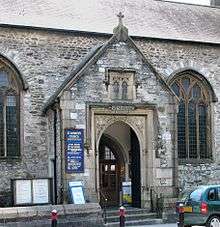Plymouth Blitz


The Plymouth Blitz was a series of bombing raids carried out by the Nazi German Luftwaffe on the English city of Plymouth in the Second World War. The bombings launched on numerous British cities were known as the Blitz.
The royal dockyards at HMNB Devonport were the main target in order to facilitate Nazi German efforts during the Battle of the Atlantic. Despite this, civilian casualties were very high and the dockyards continued in operation. The first bombs fell on the city on Saturday 6 July 1940 at North Prospect, killing three people. In early 1941, five raids reduced much of the city to rubble. Attacks continued as late as May 1944 with two minor air raids in that month.[1] During the 59 bombing attacks, 1,172 civilians were killed and 4,448 injured.[2]
The resident population fell from 220,000 at the outbreak of war to, at one point, only 127,000. In 1941 most of the children were evacuated and on any night that a raid was expected thousands of people were taken by lorry into the countryside, usually to the fringes of Dartmoor.[2]
| “ | in this town that was wasting away in reddish trails of smoke, only a few citizens wandered: the others were still in hiding; or lay, all distress ended, under the ruins. | ” |
| — André Savignon on dawn, 21 March 1941.[2] | ||
In March 1941, St Andrew's Parish Church was bombed and badly damaged. Amidst the smoking ruins a headmistress nailed over the door a wooden sign saying simply Resurgam (Latin for I shall rise again), indicating the wartime spirit, a gesture repeated at other devastated European churches. That entrance to St Andrew's is still referred to as the "Resurgam" door and a carved granite plaque is now permanently fixed there.[3]
Charles Church, destroyed by incendiaries on the nights of 20–21 March 1941, has been preserved in its ruined state as a memorial to civilian victims of the Blitz.
The Laboratory of the Marine Biological Association on the Hoe was also severely damaged on the evening of 20 March 1941. The bombardment is described in the obituary of Stanley Wells Kemp who was the director of the Association at the time.[4]
On the evening of 22 April 1941 during an attack on the central area, the communal air-raid shelter at Portland Square took a direct hit which killed 72 people. In the early 2000s (decade) this was commemorated by the University of Plymouth, which named a new building on the site after the incident, and also commissioned a local artist to create a commemorative piece.
During the Blitz the two main shopping centres and nearly every civic building were destroyed, along with 26 schools, eight cinemas and 41 churches. In total, 3,754 houses were destroyed with a further 18,398 seriously damaged.[2]
References
- ↑ "During the month of May, 1944, there were eight air raid alerts and two minor air raids in this area." ‘War Diary, 5/1-31/44’ Plymouth USNAAB, 15 June 1944, Fold3, <http://www.fold3.com/image/#1|276947863> [accessed 4 April 2012], p. 3.
- 1 2 3 4 Gill, Crispin (1993). Plymouth. A New History. Devon Books. pp. 259–262. ISBN 0-86114-882-7.
- ↑ Plymouth City Council website: Places of Worship. Retrieved 2007-10-13.
- ↑ http://sabella.mba.ac.uk/1303/01/Obituary_Stanley_Wells_Kemp.pdf
- Masters, Warren (-) Plymouth in the Blitz (The heavy raids March and April 1941)